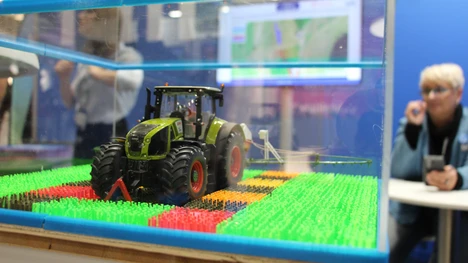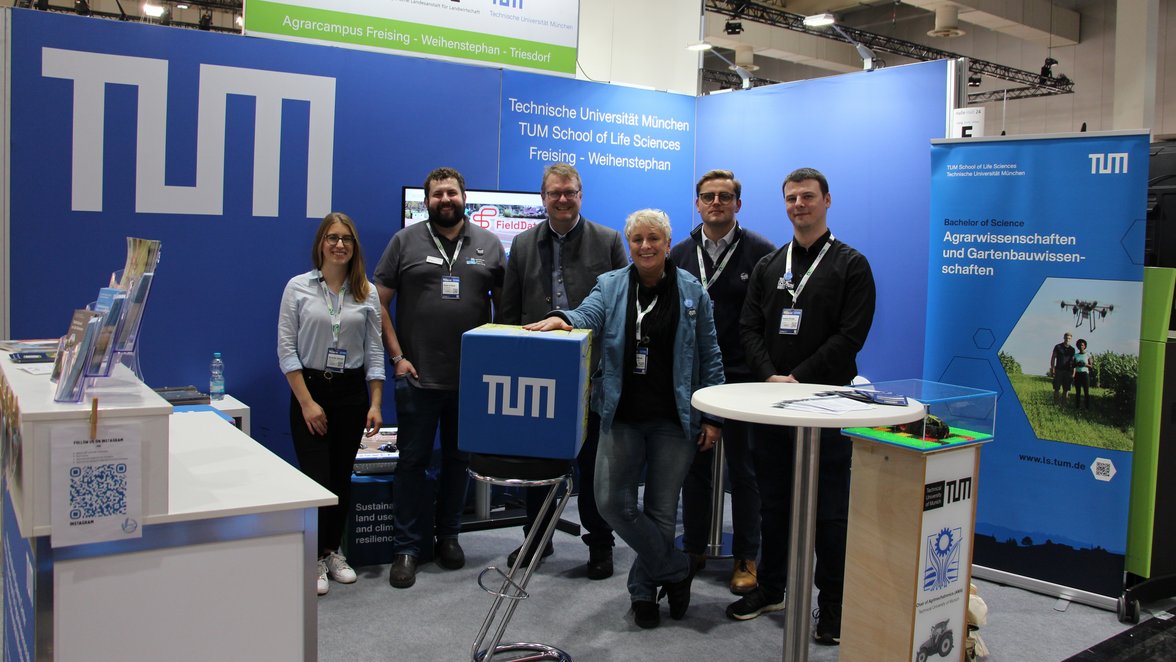Where TUM is represented at the Agritechnica:
- TUM booth: Hall 24, boothE14
- TUM Venture Labs FAB: Hall 21, agrifood start up
- FieldDataSync-Award: Wednesday, November 12th
- DigiMan Project presentation: Expert Stage on Tuesday, November 11th with Martin Mittermayer
- LiveSen-Project: Hall 21
TUM@Agritechnica 2025
Awards, Research, Campus |

The worlwide biggest fair for agricultural machinery takes place every two years in Hanover. This year, the TUM was represented by the chairs of Prof. Heinz Bernhardt and Prof. Timo Oksanen, the Hans Eisenmann-Forum and the TUM School of Life Sciences.
New ideas and projects at the booth
A small tractor on a colourful “field” is right at the front of the booth. Many visitors look puzzled at first, then the employees explain: “The colorful fields symbolize different test plots,” says Marcel Moll from the Chair of Agricultural Mechatronics. “The precision spreader creates the plots, measures them, and determines the optimized nitrogen fertilizer application.” The aim is to bridge the gap between plot tests at research institutions and agricultural practice. The exhibit represents the work on the ecoSchemeN project. The project is researching targeted fertilization on heterogeneous fields. With precision machines, represented here by the small precision spreader, site-specific and highly precise fertilization becomes scalable.
Julius Wendling from the Chair of Agricultural Systems Engineering presents the project for his doctoral thesis. The exhibit shows a metal surface with air flowing out of small holes. This causes the Plexiglas panel lying on the surface to slightly float—and move almost frictionlessly over the metal. This is also to be implemented in plowing, because: “Field cultivation with plows requires enormous energy and thus causes very high CO2 emissions. Here, solid bodies move against other solid bodies – which is very unfavorable in terms of energy, as we have losses of up to 40%.” The idea is therefore to minimize friction by using air currents from small holes, as in the exhibit.
AI in teaching, research and consulting - Expert Stage with TUM, HSWT and LfL
TUM, HSWT, and LfL are presenting a unified front not only at their booth, but also in a joint panel discussion. Following impulses by Prof. Patrick Noack from HSWT, Prof. Heinz Bernhardt and Prof. Julia Steinhoff-Wagner from TUM, the panel discusses AI in teaching, research, and consulting in agriculture. Together with Prof. Jonas Groß from HSWT, David Stäblein from LfL, and the audience, many questions arise: How is AI represented in research and teaching? What are the current issues being raised here? How far have we come in transferring research into practice?
Teaching and research: Don't be afraid – but don't trust blindly either
Conscientious use without fear – that's what students should be taught. Many students fall into either of two extremes: some don't use AI at all, while others write entire papers using AI applications. But somewhere in the middle lies the sustainable path. “AI must be used as a tool, not as a substitute for human input,” says Prof. Heinz Bernhardt. “Students need to learn both: how to use the various applications effectively and how to critically evaluate the results,” agrees Prof. Jonas Groß.
Consulting and application: complex implementation
In agricultural practice, the use of AI raises other questions: How can the applications be used across farms and countries? How reliable is the data? Can I rely on the results?
A Swiss farmer from the audience reports that he was unable to use a system from Germany. Prof. Patrick Noack explains why: “If the AI has not been trained with the appropriate data in Switzerland, it cannot make any statements about it. In addition, there are differences in terminology and regulation. ”The term ‘plant production’ encompasses completely different things in Switzerland than in Germany – the exact definition is difficult to explain to AI," says Prof. Heinz Bernhardt. Also the regulations differ: different fertilizers or fertilizer quantities are permitted, and all of this must be specifically “taught” to the AI.
David Stäblein from the LfL also responds to a question from the audience: “At the LfL, we are currently working on various use cases to provide even better support to agricultural businesses.”
A win for FieldDataSync
The FieldDataSync project from the Chair of Agricultural Mechatronics has been named this year's DLG Agrifuture Concept Winner 2025. The project is researching manufacturer-independent, wireless communication between different agricultural machines. TUM, HTW Saar, and various industry partners are involved in the project consortium. Representatives are showing the project at the booth.



